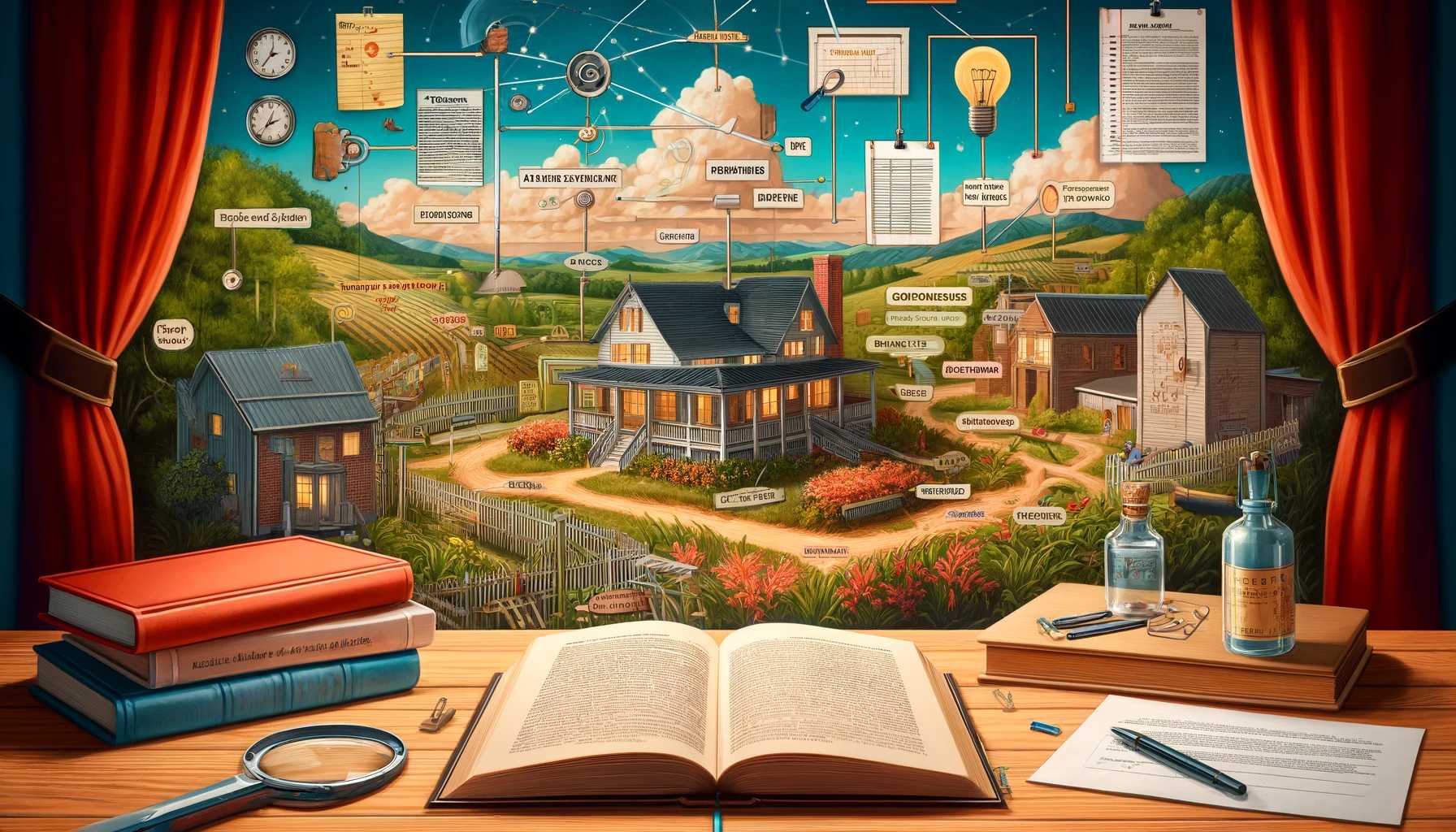The Role of Setting in To Kill a Mockingbird : A Deep Dive
Hey there, literature enthusiasts! Today, we're going to explore the
vital role of setting in Harper Lee's classic novel, "To Kill a
Mockingbird." Setting isn't just a backdrop for the story; it's a dynamic
element that shapes the narrative, influences characters, and underscores the
novel's themes. Let’s dive into how the setting of Maycomb, Alabama, enriches
this powerful tale.
1. Introduction to Maycomb: A
Snapshot of the Deep South
"To Kill a Mockingbird" is set in
the fictional town of Maycomb, Alabama, during the 1930s. This period, steeped
in the Great Depression, is crucial for understanding the economic and social
tensions that permeate the story.
Key Characteristics of Maycomb:
●
Small Town Atmosphere: Maycomb is a close-knit community where everyone
knows each other. This intimacy can be comforting, but it also means that
prejudices and gossip spread quickly.
●
Economic Hardship: The Great Depression has hit Maycomb hard,
influencing characters’ actions and attitudes.
●
Racial Segregation: The town is divided along racial lines, with
deep-seated racism affecting every aspect of life.
The
setting of Maycomb serves as more than just a backdrop; it’s a character in its
own right, influencing the events and attitudes in the novel.
2. Social Hierarchy and
Prejudice
The setting of Maycomb provides a microcosm
for examining the social hierarchy and racial prejudices of the time. The
town’s structure reflects the rigid class distinctions and racism prevalent in
the 1930s American South.
Key Elements:
●
Racial Segregation: The town is physically and socially divided.
African Americans live in a separate part of town, and their interactions with
white residents are governed by strict, unwritten rules.
●
Class Distinctions: Even within the white community, there are clear
class divisions, from the relatively well-off Finch family to the impoverished
Ewells.
Impact
on the Story:
The
setting amplifies the novel’s themes of racism and social injustice. The trial
of Tom Robinson, a black man falsely accused of raping a white woman, is a
direct result of the racial prejudices ingrained in Maycomb’s society.
3. Influence on Characters
The setting of Maycomb profoundly
influences the characters in "To Kill a Mockingbird," shaping their
beliefs, actions, and development.
Atticus Finch:
●
Moral Compass: As a lawyer and father, Atticus stands as a moral beacon
in Maycomb. His defense of Tom Robinson is a direct challenge to the town’s
racist status quo.
●
Courage and Integrity: Atticus’s actions and beliefs are highlighted
against the backdrop of a town steeped in prejudice, making his moral courage
even more striking.
Scout Finch:
●
Childhood and Innocence: Growing up in Maycomb, Scout initially sees
the world in simple terms. The events of the novel, influenced by the setting,
lead her to confront the complexities of human nature and social justice.
●
Coming of Age: The setting provides Scout with harsh lessons about
racism and inequality, contributing to her growth and understanding.
Boo Radley:
●
Mystery and Isolation: Boo’s reclusiveness is a subject of town gossip,
symbolizing fear of the unknown. The physical and social setting of Maycomb
isolates him, feeding rumors and myths.
●
Symbol of Goodness: Despite the town’s fear and prejudice, Boo
ultimately emerges as a figure of goodness, protecting Scout and Jem.
4. Atmosphere and Mood
The setting of Maycomb creates a specific
atmosphere and mood that permeates the novel, influencing how readers perceive
the story.
Atmospheric Elements:
●
Slow-Paced Life: The leisurely pace of life in Maycomb reflects the
town’s resistance to change, highlighting the entrenched social norms and
resistance to progress.
●
Tension and Foreboding: The hot, oppressive Southern climate mirrors
the rising tension as the trial approaches, creating a sense of foreboding and
inevitability.
●
Gothic Elements: The Radley house adds a gothic element to the setting,
with its aura of mystery and fear, contributing to the novel’s mood of suspense
and intrigue.
Impact
on the Reader:
The
atmosphere created by the setting immerses readers in the world of Maycomb,
making the social issues and personal struggles more vivid and impactful.
5. Symbolism of Place
Specific locations within Maycomb hold
symbolic meaning, enriching the novel’s themes and characters.
The Radley House:
●
Fear and Mystery: The house represents the unknown and the fears that
arise from it. Boo Radley’s isolation and the children’s fascination with him
symbolize the town’s fear of what is different or misunderstood.
●
Transformation: By the end of the novel, the Radley house shifts from a
place of fear to one of unexpected safety, symbolizing the importance of
understanding and compassion.
The Courthouse:
●
Justice and Injustice: The courthouse is the center of Maycomb’s legal
system, representing both the potential for justice and the reality of racial
injustice. The trial of Tom Robinson highlights the biases that pervert the
course of justice.
●
Public Scrutiny: Located in the town square, the courthouse is a place
where the private becomes public, underscoring the communal nature of Maycomb’s
prejudices.
The Finch Household:
●
Moral Center: The Finch home is a place of learning, growth, and moral
integrity. It stands in contrast to the broader prejudices of Maycomb,
symbolizing the possibility of goodness and change.
6. Historical Context
Understanding the historical context of
Maycomb enhances our comprehension of the novel’s setting.
The Great Depression:
●
Economic Struggles: The economic hardships faced by characters like the
Cunninghams reflect the widespread poverty of the time, influencing their
actions and perspectives.
●
Social Tensions: The economic instability exacerbates existing social
tensions, making the town’s racial and class prejudices more pronounced.
Jim Crow Laws:
●
Legalized Racism: The setting during the Jim Crow era provides a
backdrop of institutionalized racism, essential for understanding the trial’s
outcome and the broader social dynamics.
●
Resistance to Change: The setting highlights the deep-rooted resistance
to racial equality, a central theme of the novel.
Conclusion: The Integral Role
of Setting in "To Kill a Mockingbird"
The setting of "To Kill a
Mockingbird" is not just a backdrop but a crucial component that shapes
the narrative, characters, and themes. Maycomb, Alabama, with its social
hierarchies, racial divisions, and historical context, provides a rich
environment that amplifies the novel’s exploration of morality, justice, and
human complexity. By understanding the setting, readers gain deeper insight
into the forces that drive the story and the timeless messages Harper Lee
conveys.
So next time you read "To Kill a Mockingbird," pay close
attention to the setting. It’s a key player in this unforgettable tale,
influencing every aspect of the story and enriching your reading experience.








